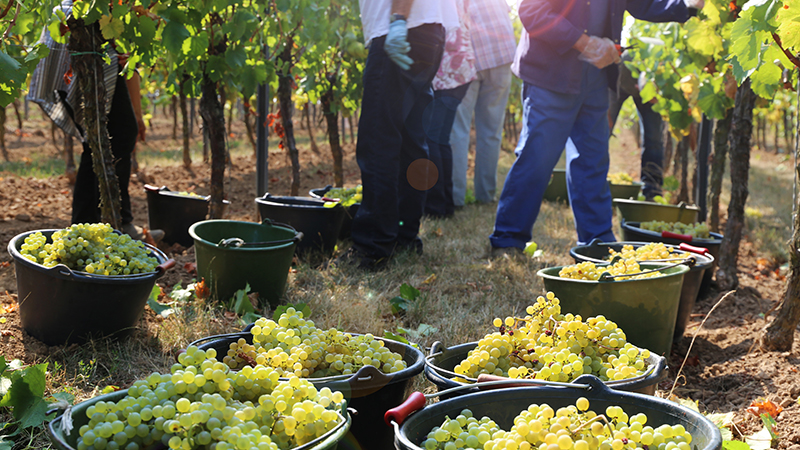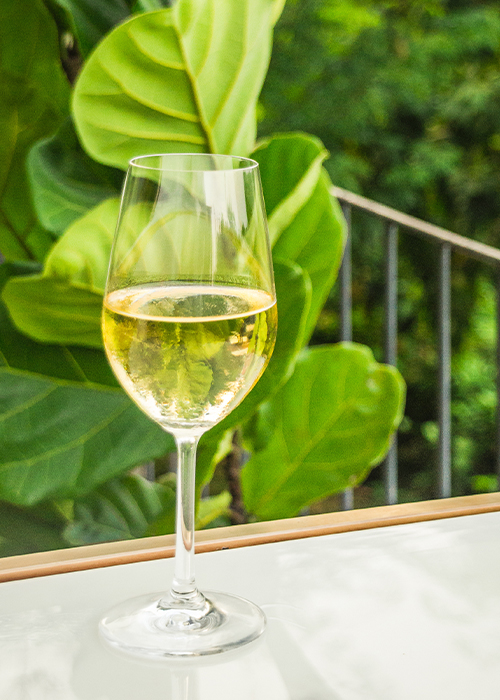
Winemaker Alberto Guolo left his native Italy to work in the Chilean wine industry for one main reason: He loves Sauvignon Blanc. It’s his favorite grape variety, so you can imagine his enthusiasm when he talks to his fellow winemakers about the experimentation with and potential for the grape in the South American country.
“The accumulated knowledge brought by a new generation of winemakers has permitted a substantial lift in terms of quality of Sauvignon Blanc,” Guolo says. “In the past, much of the focus was put on Cabernet and Carménère, but, in my opinion, Sauvignon Blanc represents the future of Chilean viticulture. It’s going to take a protagonist role.”
Guolo is the winemaker at Viña Casa del Bosque, one of the premier producers in the Casablanca Valley, a globally recognized region for top-quality Sauvignon Blanc wine. Here, the extremely cool climate conditions, focus on low yields, and general water deficiency leads to a very aromatic style that’s welcomed by consumers. It’s so popular that, since 1990, vineyards planted with Sauvignon Blanc in the region have increased 5,900 percent.
This is just one of many examples in the country. Chile now has more than 15,300 hectares of Sauvignon Blanc vineyards, which span from the Atacama Desert in the north all the way to the southern tip of the continent — making it the third-largest producer of the white wine in the world. By comparison, it generates about half as much Sauvignon Blanc as France, which, for a much, much younger wine-producing country, says a lot.
The boom in Chilean Sauvignon Blanc started a mere 20 years ago, and the amount of growth in those two decades has been exponential. Much of that can be attributed to the vast range of experimentation by winemakers up and down the coast, playing with various clones, exposures, vineyard sites, and production techniques, like cold fermentation and stainless-steel aging.

Now, the country is hitting its stride. Winemakers have a more thorough understanding of Chile’s terroir, having found immense success in cool climates along the coast and in the foothills of the Andes Mountains. Overall, the wines feature fresh fruit flavors, zesty acidity, and, possibly most importantly, hard-to-beat value per dollar for the customer. As the chief executive officer of Viña Koyle, Cristóbal Undurraga, says, “Chile has the capacity to conquer admirers.”
Digging into the Chilean winemaking landscape, you’ll find that the regions famed for Sauvignon Blanc range widely in terms of their diversity of soils, climates, and nuances of the resulting wines. While they all focus on citrus and tropical flavors with an underlying salinity, regions like the Atacama, Limari, and Maule, offer more mineral-driven styles akin to France’s Loire Valley, while the cool, foggy climate of the Colchagua, Casablanca, and Leyda valleys create that delicious, fruit-forward style so often associated with South American Sauvignon Blanc.
Given the drought issue that has plagued the country for the past 15 years, biodynamic farming techniques have proven invaluable in maintaining a sustainable vineyard for wineries around the country. Julio Bastias, the head winemaker at Matetic Vineyards in San Antonio, explains that biodynamic farming takes a close look at the land, working to create microbiologically active soils. When that’s achieved, he says, he can hold back on irrigation. The very precise water status records keep vines growing nicely without needlessly using up the precious water supply.
It goes hand in hand with his team’s focus on creating balanced, concentrated Sauvignon Blanc that speaks to the winery’s location just five miles from the Pacific Ocean. For him, the wine’s combination of spicy and tropical flavors along with acidity and balance on the palate makes for an iconic Chilean white wine.
Viviana Navarrete Capurro, chief winemaker at Viña Ledya in the Leyda Valley, attributes the increase in quality to the collective deep soil research and organic soil management, too. She notes that more than 80 percent of the country’s wineries are working toward sustainability in the vineyards, whether that’s in the form of higher-density planting, establishing vineyards in new coastal locations, or trying different clonal selections. It’s allowed wineries from all parts of the country to design wines that speak to their individual terroirs and pass that complexity and diversity on to consumers.
While you could attempt to generalize, there’s no one distinct Chilean Sauvignon Blanc flavor profile. The signifying characteristic is vibrant acidity.
“Depending on the soils, you can go from creamy, rounder palates to more refined, but in absolutely all of these Sauvignon Blancs you will get crisp acidity and a fresh vibrant palate,” Navarrete Capurro says. “It’s reaching into a great level, more elegance, more terroir driven, with better winemaking techniques, resulting in wines with strong character that can age beautifully in the bottle.”
 Winemakers have made progress in the wineries, too, working with cold fermentation, less skin contact, stainless-steel aging, and refrained use of oak, if part of the process at all. Veramonte’s winemaking team uses a combination of stainless steel, concrete, and neutral oak for its Ritual line Sauvignon Blanc. Diego Rivera, winemaker at Garces Silva, has lowered his use of sulfur dioxide by 40 percent and lengthened the time the wine spends on the lees after fermentation. “Knowledge is part of the know-how,” Rivera says. “Growers now have a clearer view on where and how to get the best of their potential.”
Winemakers have made progress in the wineries, too, working with cold fermentation, less skin contact, stainless-steel aging, and refrained use of oak, if part of the process at all. Veramonte’s winemaking team uses a combination of stainless steel, concrete, and neutral oak for its Ritual line Sauvignon Blanc. Diego Rivera, winemaker at Garces Silva, has lowered his use of sulfur dioxide by 40 percent and lengthened the time the wine spends on the lees after fermentation. “Knowledge is part of the know-how,” Rivera says. “Growers now have a clearer view on where and how to get the best of their potential.”
Chilean wines have become much more premium in the past decade, but consumers can typically find these outstanding bottles of wine for $25 and under. The quality equates to something much more expensive, says Undurraga. He believes this is an asset for Chilean wine: Sauvignon Blanc offers a sense of place for consumers who are always looking for good value.
The wines also come in slightly cheaper than their main competitor: New Zealand. Rivera explains that New Zealand has done an impressive job of establishing Sauvignon Blanc as the country’s flagship variety, while Chile has been less direct, marketing its standout red wines in addition to Sauvignon Blanc. “That has a market effect,” Rivera adds.
Many Sauvignon Blanc winemakers in Chile have actually worked in New Zealand and professionals like Bastias fully respect New Zealand Sauvignon Blanc. He describes them as “great and well-balanced wines.” But Chilean winemakers are quick to note the differences between the two: Namely, Chile offers more diversity of flavors and styles, with stronger aromatics and higher acidity.
That’s thanks to its cool-climate vineyards. No matter what region, Sauvignon Blanc finds itself along the coastlines, benefiting from the maritime air, or in the foothills of the Andes, at a higher elevation that sees a chilled mountain breeze. It gives the wine its bright acidity and long finish that sets it apart from the creamy, exuberant styles of New Zealand.
The kicker, then, is an additional feature of Chilean Sauvignon Blanc: concentrated body. That comes from the shallow, coastline vineyards that produce lower yields. “You can find differences in winemaking and styles,” says Guolo, “but this sensation in the mouth is the most compelling one.”
To discover some of Chile’s incredible Sauvignon Blanc wines, check out the list below:
Casas del Bosque, La Cantera Sauvignon Blanc 2020
Veramonte, Organic Reserva Sauvignon Blanc 2021
Leyda, Reserva Sauvignon Blanc 2021
La Rosa, Contempo Sauvignon Blanc 2021
Los Vascos, Sauvignon Blanc 2021
Montes, Classic Series Sauvignon Blanc 2021
Las Mulas Organic Wine Sauvignon Blanc 2021
Morandé Gran Reserva Sauvignon Blanc 2020
Santa Ema, Select Terroir Sauvignon Blanc 2021
Concha y Toro, Gran Reserva Sauvignon Blanc 2021
Luis Felipe Edwards, Marea Sauvignon Blanc 2021
Baron Philippe de Rothschild, Escudo Rojo, Reserva Sauvignon Blanc 2020
Tabali, Talinay Sauvignon Blanc 2021
Maquis, Calcu Gran Reserva Sauvignon Blanc/Semillon 2020
Matetic, EQ Coastal Sauvignon Blanc 2020
Koyle, Costa La Flor Sauvignon Blanc 2021
This article is sponsored by Wines of Chile.


